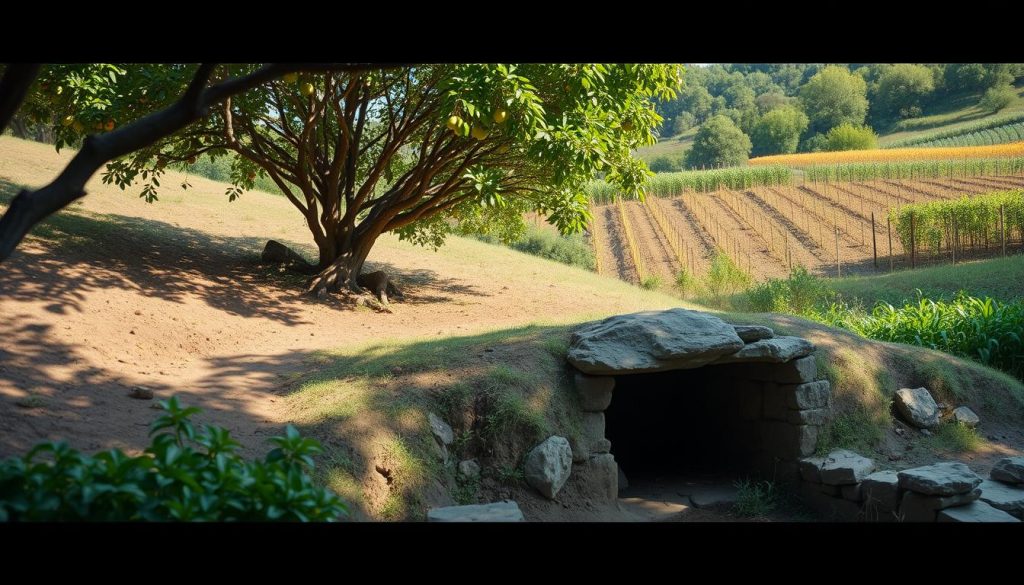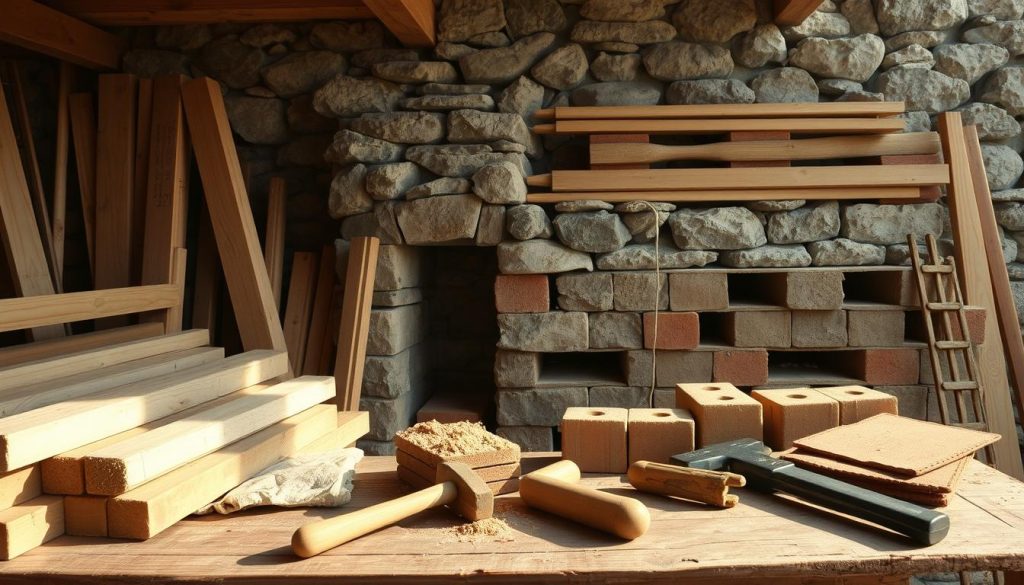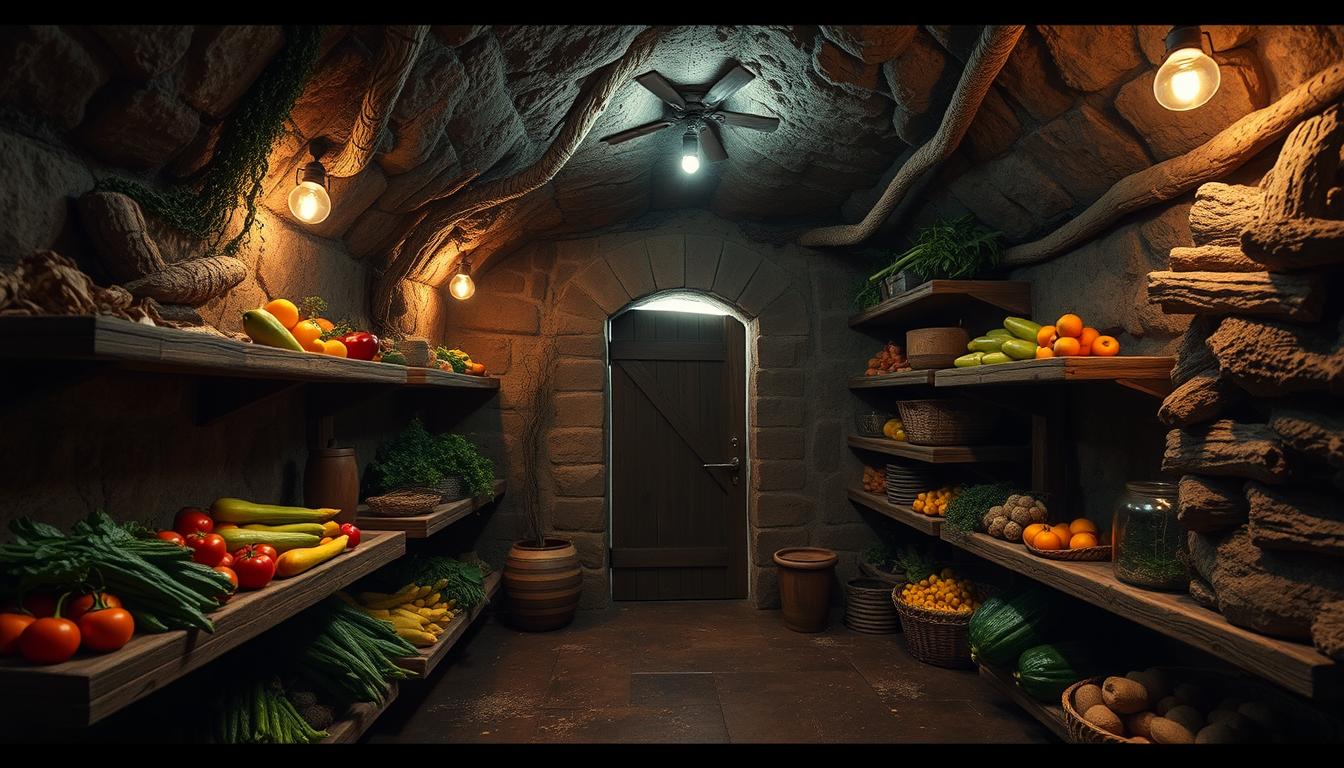Creating an efficient root cellar is key for keeping food fresh all year. It’s a natural, eco-friendly way to store your produce. Root cellar construction uses the earth’s cooling and insulating powers, making it a vital part of sustainable living.
When building a root cellar, focus on location, insulation, ventilation, and organization. These elements help make your underground storage space effective. Let’s explore the basics to make sure your root cellar meets your needs.
Understanding Root Cellars and Their Benefits
Root cellars are a traditional way to keep food fresh when it’s not in season. They use the earth’s natural cooling to store food without needing electricity. This makes them a great choice for saving energy and food.
What is a Root Cellar?
A root cellar is a space under the ground or partially buried. It uses the earth to keep food cool and humid. This makes it perfect for storing carrots, potatoes, and apples.
Advantages of Using a Root Cellar
Root cellars offer more than just cool storage. They save energy by not using electricity, which cuts down on costs. They also keep food’s nutrients and taste, making meals healthier and tastier.
Ideal Foods for Storage
Root cellars are great for many types of food. They’re perfect for beets, turnips, cabbages, and winter squashes. This way, you can keep your home full of fresh food all year.
Selecting the Right Location for Your Root Cellar

Finding the perfect spot for your root cellar is key to its success. Let’s look at what matters most.
Considerations for Placement
When picking a spot for your cellar placement, think about the soil, water table, and how easy it is to get to. A great spot has good drainage to keep water out. It should also be easy to reach but not too obvious to keep temperatures steady.
The best spots often have natural slopes. These make building easier and help keep the cellar warm.
Natural vs. Constructed Cellars
There’s a big debate about using natural spots versus building a cellar. Natural places like caves or hillsides have natural insulation and cost less to build. But, built cellars let you design and place it just how you want, based on space and taste.
Choosing the right site selection is crucial for your root cellar’s success. Think about all the details to make sure it meets your needs and keeps food fresh.
Planning Your Root Cellar Layout

Creating a good layout for your root cellar is key. It helps you store more and makes it easy to get to what you need. Think about the size of your cellar to fit everything comfortably. Also, focus on making it easy to use and ergonomic.
Measurements and Dimensions
Start by figuring out the right size and shape. The height of your ceiling is important for comfort. It should let you move around easily.
Make sure your cellar is big enough for different storage spots. Use adjustable shelves to keep things organized. This makes storing food easier.
Designing for Accessibility
Accessibility is very important. You want a space that everyone can use. Make sure everything is within reach and easy to get to.
Use wide paths for easy movement. Your design should help you store things in a way that makes sense. For example, put heavy items on lower shelves and lighter ones up high.
Choosing Suitable Building Materials

Choosing the right materials for a root cellar is key. Each material has its own benefits and things to consider. These include thermal mass, durability, and cost. Knowing these can help you make a smart choice for your root cellar.
Wood vs. Concrete: Pros and Cons
Wood and concrete are top picks for root cellar materials:
- Wood: Wood is a classic choice, giving a natural look. But, it might not be as strong or resistant to moisture. Wood can rot and attract pests, which can shorten your root cellar’s life.
- Concrete: Concrete is great for keeping temperatures steady because of its thermal mass. It’s strong, lasts long, and keeps moisture out. But, it’s pricier than wood, both in cost and installation.
Insulation Options for Temperature Control
Insulation is crucial for a root cellar’s success. It keeps the inside temperature steady. Here are some effective insulation options:
- Straw Bales: Straw bales are eco-friendly and affordable. They insulate well but can get damaged by moisture. You might need extra protection.
- Rigid Foam: Rigid foam is top-notch for insulation and keeps moisture out. It’s pricey but durable, ensuring your food stays fresh.
- Fiberglass Batting: Fiberglass is cheap and simple to put in. It insulates well but might not work in very wet places without a moisture barrier.
In earth-sheltered construction, picking the right insulation is key. It helps your root cellar’s thermal mass. This keeps your food fresh for longer.
Ventilation Essentials for Root Cellars
Good root cellar ventilation is key to keeping your food fresh. It helps control temperature, cuts down on ethylene gas, and stops mold. This means your fruits and veggies will last longer.
Importance of Airflow
Air movement in your root cellar is vital. Without it, your food can spoil fast from too much moisture and not enough oxygen. Ventilation keeps the air from getting stale, helping to stop mold. It’s important to keep air flowing, either naturally or with a machine, for a good root cellar.
Designing Ventilation Systems
There are many ways to set up ventilation in your root cellar. You can use simple vents or more complex machines. Vents let air move between inside and outside. Machines let you control air flow, keeping temperatures balanced.
It’s crucial to design your ventilation system right for your space. A well-made system will keep your food in the best condition. It helps prevent mold by creating a great environment for your food.
Maintaining Ideal Temperature and Humidity
Creating the perfect cellar environment for food storage is all about temperature control and humidity management. A balanced root cellar keeps your food fresh and full of nutrients. It also stops it from spoiling.
To get this right, you need the right tools and techniques. Let’s explore some key tips and equipment for maintaining these conditions.
Tools for Temperature Regulation
For effective temperature control, use tools like thermometers and climate control systems. Basic thermometers let you check the cellar’s temperature. This way, you can adjust the heating or cooling as needed. For places with big temperature changes, a digital thermostat offers more precise control.
- Thermometers: Basic and digital options to monitor temperatures.
- Heating and Cooling Systems: Depending on your local climate, you might need heaters, fans, or air conditioners to maintain a stable environment.
- Insulation: Proper insulation materials help retain the desired temperature by minimizing external influences.
Tips for Humidity Control
Effective humidity management is just as crucial. The best humidity level (85-95%) can be achieved through several methods.
- Water Trays: Placing trays of water in the cellar can help increase humidity levels by providing additional moisture.
- Proper Ventilation: Good airflow prevents mold and ensures balanced humidity. Installing vents and fans can enhance circulation.
- Insulation: Suitable insulation materials also play a crucial role in controlling condensation and maintaining steady humidity levels.
- Hygrometers: These devices are used to monitor humidity, allowing you to make necessary adjustments promptly.
By managing both temperature control and humidity management well, you can create an ideal cellar environment. This keeps your stored produce in top condition.
Organizing Your Root Cellar Efficiently
Organizing your root cellar well helps use space better and keeps food fresh. You can do this by using smart shelving ideas and labeling things right. This makes sure you can find what you need easily and manage your food well.
Shelving Ideas
For good organization, think about different shelving options. Adjustable shelves fit various sizes and weights of food. Use strong materials like metal or treated wood for lasting quality. Modular shelves are also great because they can change with your needs.
Labeling and Inventory Strategies
Labeling and keeping track of what you have are key to a tidy root cellar. Use clear, waterproof labels to mark items and their dates. A FIFO system helps use the oldest items first, cutting down on waste. Keeping a detailed list of what you have helps plan for the future. These steps help you store food better.
Harvesting and Storing Produce
Proper harvesting and storage are key to keeping your fruits and veggies fresh. By following the right storage methods and harvesting tips, you can keep your produce fresh longer. Here are some important guidelines to help you do just that.
Best Practices for Harvesting
Timing is everything when it comes to harvesting. Picking your fruits and veggies at the right time is crucial for their taste and freshness. Also, be gentle when handling them to avoid bruising, which can cause them to spoil faster. Here are some key tips:
- Pick fruits and vegetables early in the morning when temperatures are cooler.
- Use clean, sharp tools to make clean cuts and minimize damage.
- Avoid washing produce before storage to prevent excess moisture, which can cause rot.
Packing and Storage Techniques
How you pack and store your produce can greatly affect its shelf life. Keep items in a cool, dark, and well-ventilated place like a root cellar. Here’s how:
- Use breathable materials like straw or sawdust to insulate and protect each item.
- Organize fruits and vegetables in single layers to improve airflow and reduce mold risk.
- Regularly check your stored produce for any signs of spoilage and remove affected items promptly.
By following these harvesting and storage tips, you can keep your produce fresh for longer. This way, you can enjoy delicious, home-grown foods all year round.
Regular Maintenance and Monitoring
Keeping up with regular maintenance and monitoring is key for your root cellar. By doing frequent checks and fixing issues quickly, you help your storage stay in top shape. This care is crucial for keeping your food fresh and your cellar healthy.
Routine Checks and Repairs
Regularly inspect your root cellar for damage. Look for cracks that could let in moisture or pests. Also, check for leaks to avoid water damage. Make sure the ventilation and insulation work well to keep the right temperature and humidity.
Fixing small problems early can save you from big repairs later. This keeps your cellar running smoothly.
Signs of Trouble to Watch For
Be on the lookout for signs of trouble during your maintenance checks. Mold or mildew means there might be too much moisture. Pests like rodents or insects show structural weaknesses. Unusual smells can mean spoilage or contamination.
By watching for these signs, you can fix issues fast. This helps keep your stored food fresh and your cellar in good condition.

